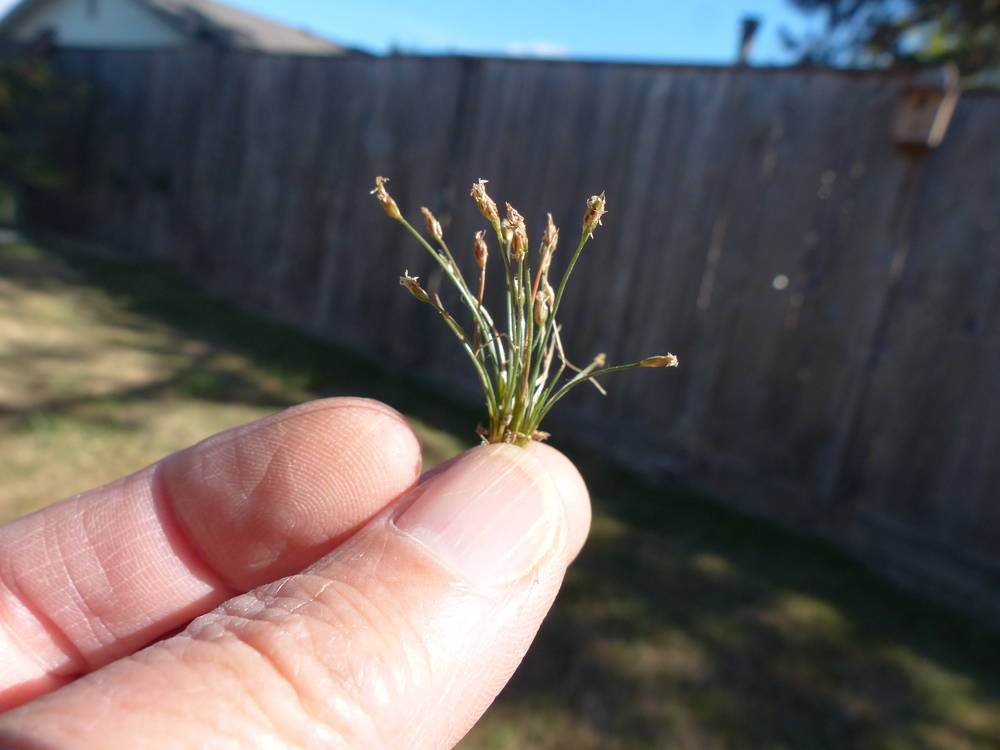Eleocharis bella
Eleocharis rostellata
delicate spikerush, pretty spikerush
walking sedge, walking spikerush
often ascending or spreading, 4-angled or terete 1–7 cm × 0.2–0.3 mm.
1.5–3 times as wide as thick, 20–100 cm × 0.35–2 mm; wiry; some culms arching or decumbent and rooting at tips.
ovoid, 1.5–4 × 0.8–2 mm; floral scales 4–15, 8 per mm of rachilla, 1–1.5 × 0.5–0.7 mm;
midrib obscure to somewhat keeled;
apex narrowly acute to acuminate, slightly recurved.
5–17 × 2.5–5 mm;
spikes on stolons rudimentary and sometimes producing bulbs;
proximal scale empty; amplexicaul, 2–4 mm, subproximal scale with flower; floral scales 20–40, 2–3 per mm of rachilla, 3.5–6 × 2–3 mm;
apex entire, rounded to subacute.
perianth bristles absent;
anthers 0.3–0.5 mm;
stigmas 3.
perianth bristles, equaling achene or tubercle;
anthers 2–2.4 mm;
stigmas 3.
with about 6–10 rather prominent angles and longitudinal ridges, broadly ovoid; less than 2 times longer than wide; (0.55)0.65–0.75 × 0.3–0.4 mm; fine horizontal ridges distinct, 20–30.
often very variable within one plant, 1.5–2.5 × 1–1.2 mm;
beak to 1 × 0.6 mm.
often splitting;
apex acute.
not splitting;
apex usually reddish.
mostly appressed; pyramidal, often depressed, 0.1–0.2 × 0.1–0.25 mm.
when present pyramidal; to 0.5 × 0.3 mm.
Eleocharis bella
Eleocharis rostellata
Exposed lake margins and streamsides, wet meadows. 0–2100 m. BR, BW, ECas, Owy, Sisk, WV. CA, ID, NV, WA; northeast to MT, southeast to NM, south to Mexico. Native.
Eleocharis bella has sometimes been considered a variety of E. acicularis, which is a rhizomatous perennial with larger floral scales, anthers, and achenes. Hybrids between the two are unknown.
Wet, often alkaline soils on shorelines and around springs and fens. 50–1500 m. BR, Col, ECas, Owy. CA, ID, NV, WA; north to British Columbia, east to New Brunswick, south to Mexico and West Indies. Native.
When not producing stolons, E. rostellata can resemble E. suksdorfiana, but the latter species has a flower in the proximal scale. Eleocharis rostellata can form large pure stands.
Barbara Wilson, Richard Brainerd, Nick Otting
Barbara Wilson, Richard Brainerd, Nick Otting
- Local floras:
CA,
OR,
WA
- Local Web sites:
CalFlora,
CalPhotos,
Flora NW,
PNW Herbaria
WildflowerSearch
iNaturalist (observations)
USDA Plants Database
- LBJ Wildflower Center
- SEINet
- Plants of the World Online
- Encyclopedia of Life
- Wikipedia
- Google Image Search
- Local floras:
BC,
CA,
OR,
WA
- Local Web sites:
CalFlora,
CalPhotos,
Flora NW,
PNW Herbaria
WildflowerSearch
iNaturalist (observations)
USDA Plants Database
- LBJ Wildflower Center
- SEINet
- Plants of the World Online
- Encyclopedia of Life
- Wikipedia
- Google Image Search




